After the very interesting experience revealing that there is a lot of fun to be found in this kite, I decided to improve the feature a little. For the first test flights, I decided to use duck tape to keep the glass fibre rod in position. Without this tape, the rod would just slide to either side and not keeping up 3D shaping the sail. But using tape is not a permanent way of positioning the rod.
So I started thinking about a better way to keep things in place and I came up with the idea of using two “stripes” of dacron running from the top of the kite down to the pointy part, cut small slits in the dacron pieces in which to thread the GF rods thus keeping them in position! In addition to keeping the rods in position, these pieces of dacron will also act to reinforce the sail and reduce wear from the down spars when flowing without the GF rods inserted. Two for the price of one!
So I disappeared into my basement and came out with the required stuff; a useful length of dacron, a pair of scissors, a roll of tape, a ruler, a dressmaking marker pencil, Stanley’s type of knife and of course the sewing machine. I was ready to tinker!
First I split the dacron in two, ending up with two pieces half the width of the original piece; one for each down spar. Then I marked the pieces of dacron using the dressmaking marker pencil every three centimetres along with each piece. Now over to some cutting. At each mark, I cut a 1cm slit (for the GF rods).
The next step was to fix the dacron to the sail by using some tape and when done I brought it all over to the sewing machine and started carefully sewing the dacron onto the sail while gently removing the pieces of tape.
With both pieces of dacron fixed to the sail, it was time to assemble the kite. First I inserted the three pieces of carbon rod making up the leading edge and then I inserted the two down spars into the connectors. It all started to look like a normal QLK again, but with a flat sail, not the 3d shaped one. But now the GF rods come in to play!
One by one I removed the down spars and slid two connectors onto each of them before inserting the down spars into their connectors again. Then I carefully slid one of the short CF rods through the slits in the dacron and inserted each end into the two connectors on the down spar and repeated the process for the other down spar.
Now we’re talking!
The GF rod pushed the sail away from the down spar thus significantly altering the shape of the sail; 3D!
This whole process is documented in the gallery below. Check them out and see how this very simple modification creates an interesting 3D shape of the sail. This modification also allows for rapid changes to the settings too so you can play with different sail shapes on the fly. By pushing the connectors closer together, the bow takes on a different shape and pushes the sail further away from the down spar. And of course, increasing the distance between the connectors makes for a flatter sail.
You can also play along by moving the pair of connectors up and down the down spar, thus changing the position of the bow and see what happens to the kite’s flying characteristics.
So now the prototype 3D kite is ready for its third test flight and I’m really looking forward to seeing if this modification works out in the flying field and of course to play around with the settings and see what happens.
And while waiting for the reports from that test flight … Just Fly!
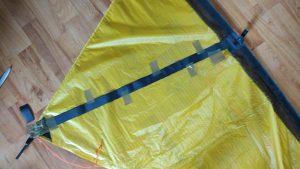
The dacron on the sail 
Dacron close up 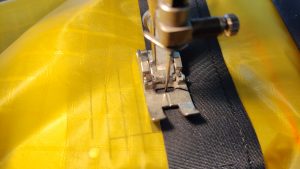
Sewinf the dacron onto the sail 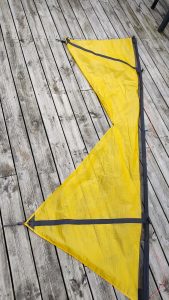
Done! Let’s assemble the kite 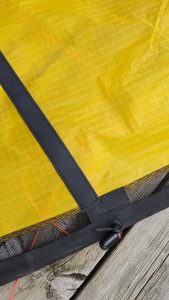
Details 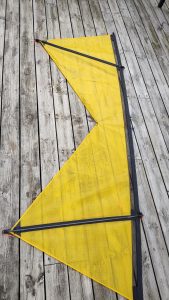
The frame is in place 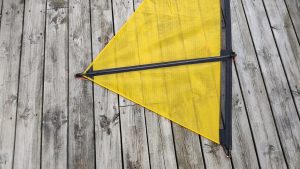
Down spar 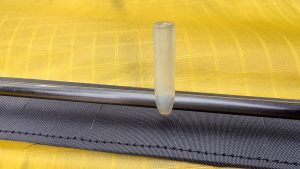
Two of these on the down spar 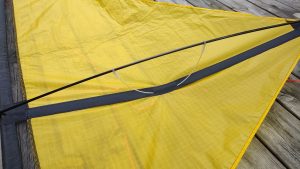
And you can insert the GF rod 
The bow pushing the sail away from the down spar 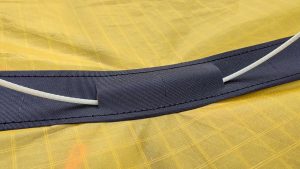
Detail 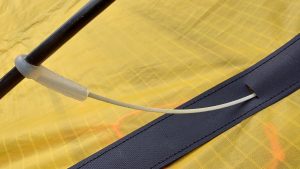
Even closer 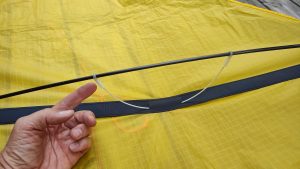
You can move the bow up and down the spar 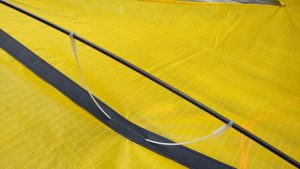
This will alter the 3D shape of the sail 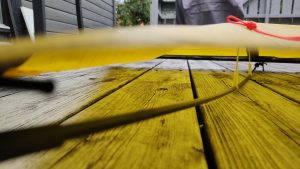
Not flat on the ground anymore 
Complete! 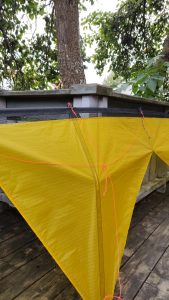
You can clearly see the 3D shape 
Let’s go flying!





2 responses
This method of adjusting the standoff height is of interest for me. I don’t do flickflacs with quads, so if according to you they are easy with the mod, perhaps I could learn with the mod and then gradually reduce the standoff height approaching that of an ordinary rev-like wing. Perhaps one would need a string parallel to the downspar between the two fittings to prevent them sliding during rainy days or when the fittings are close to each other?
Very good that you got rid of the duct tape before it left permant marks. It wouldn’t have taken long until the tape glue would have left leave permanent residues.
This method of adjusting the standoff height is of interest for me. I don’t do flickflacs with quads, so if according to you they are easy with the mod, perhaps I could learn with the mod and then gradually reduce the standoff height approaching that of an ordinary rev-like wing. …
Yes, I suppose that is a way to go. Just do it! 🙂
Perhaps one would need a string parallel to the down spar between the two fittings to prevent them sliding during rainy days or when the fittings are close to each other? …
If you find connectors that are a really, really tight fit, I’m not sure if this is going to be a problem. But a string might solve this if it becomes reality. Or you can use a short piece of electrical tape or some c-clips to prevent the connectors from sliding. But like said, I hope a tight fit connector will stay in place.
Very good that you got rid of the duct tape before it left permant marks. It wouldn’t have taken long until the tape glue would have left leave permanent residues….
Yes, I’m not too fond of using duct tape like this on the sail, but it was a quick solution to an issue that now is solved with two pieces of dacron!
…and by the way, these pieces of dacron also helps to prevent sail wear no matter if the kite is flown 3D or flat! 🙂